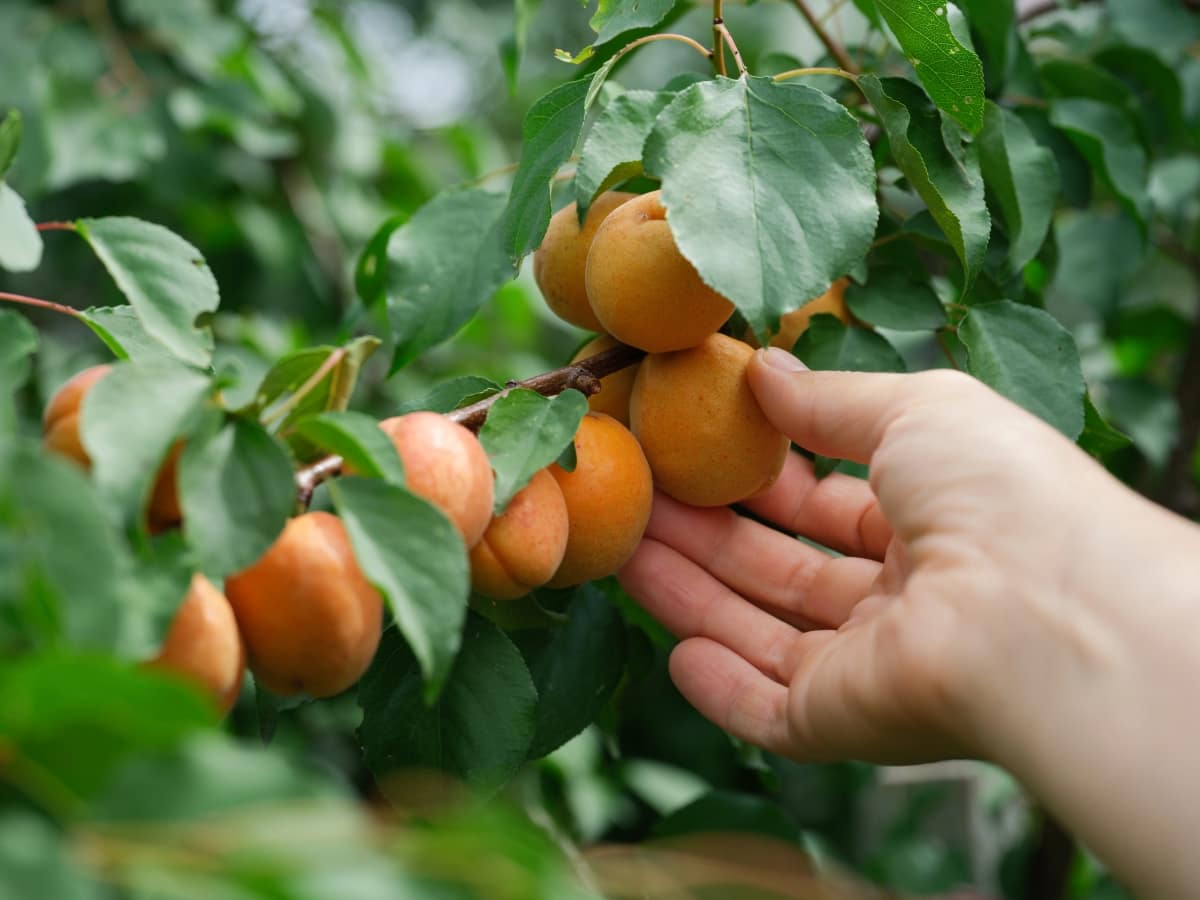When it comes to harvesting Apricots, timing is everything. The optimal time to harvest these delicious fruits depends on several factors that can greatly impact their taste and quality. One key factor is the variety of Apricots being grown. Different varieties have varying maturation times, with some ripening earlier in the season than others.

Another important consideration is the local climate and weather conditions. The maturity stage of the fruit also plays a vital role in determining when to harvest Apricots. Furthermore, attention to visual cues such as color changes can help determine if Apricots are ready for harvest.
Harvesting Apricots
Best Practices for Harvesting Apricots: Techniques for Maximum Yield and Quality
Timing is key when it comes to Apricot harvesting. The fruits should be picked at their peak of ripeness to avoid any loss in flavor or texture. Look for visual cues such as a vibrant color, firmness, and uniform size to determine if the fruit is ready for picking. To minimize damage during harvesting, use gentle handling techniques. It is advisable to hold the fruit gently from its base while twisting it slightly until it detaches from the tree.
Using sharp pruning shears or scissors to cleanly cut off their stems’ Apricots is recommended. This helps prevent any unnecessary damage to both the fruit and the tree. Another technique that can enhance yield and quality is selective thinning. Removing excess fruits early on allows more nutrients and energy to be directed towards fewer fruits, resulting in larger-sized Apricots with better flavor. It’s important not to overcrowd your harvest containers as this can lead to crushing and bruising of the delicate Apricots.
Preparing for Apricot Harvest: Essential Tools and Equipment
- Pruning Shears: These will be your go-to tool for cutting off ripe Apricots from the tree. Look for a pair with sharp blades that can easily cut through branches.
- Harvesting Baskets or Buckets: You’ll need something to collect the harvested fruits in as you work through the orchard. Opt for baskets or buckets with handles for easy transport.
- Ladders: Depending on the height of your trees, you may need a sturdy ladder to reach those higher branches. Make sure it is stable and secure before climbing up.
- Protective Clothing: Apricot trees can have thorny branches, so wearing gloves and long sleeves is recommended to protect yourself from scratches while picking fruit.
Assessing Apricot Ripeness: Visual and Tactile Indicators
When it comes to harvesting Apricots, timing is everything. Knowing how to assess the ripeness of these delicious fruits is crucial for achieving optimal flavor and quality. While each variety may have its unique characteristics, there are some general visual and tactile indicators you can look out for. Visual cues play a key role in determining Apricot ripeness. Depending on the variety, a ripe Apricot will typically have a vibrant orange or golden color. Avoid picking still green or pale yellow fruits, which are likely underripe and lack sweetness.
In case you missed it: Apricot Farming in Greenhouse: Advantages, Challenges, and Best Practices

Another way to determine if an Apricot is ripe is by gently pressing it with your fingers. Ripe Apricots should yield slightly but not be too soft or mushy when pressed. The fruit should still hold its shape without feeling overly firm. In addition to color and texture, fragrance can provide valuable insight into the ripeness of an Apricot. Ripe Apricots often have a sweet, fragrant aroma that becomes more pronounced as they approach peak ripeness.
Harvesting Apricots: Step-By-Step Guide to Ensure Minimal Damage
- Assess ripeness: Before picking the fruits, ensure they are ripe enough for harvest. Look for a vibrant orange color and a slight softness when gently pressed.
- Choose the right time: Aim to harvest in the early morning or late afternoon when temperatures are cooler, as this helps preserve the quality of the fruit.
- Use sharp tools: Pruning shears or scissors should be your go-to when harvesting Apricots. Make clean cuts near where the stem meets the branch.
- Handle with care: Hold each Apricot gently by its stem and twist it slightly until it detaches from the tree.
- Collect in small containers: Instead of tossing them into large baskets or bags where they can get easily bruised, place harvested Apricots carefully into smaller containers or trays that provide cushioning.
- Avoid piling up too high: While collecting your bounty, avoid stacking too many layers of fruit on top of each other, as this can lead to squished or damaged produce at the bottom.
The Importance of Proper Handling during Apricot Harvest
Proper handling during Apricot harvest is crucial to maintaining the fruit’s quality and marketability. The delicate nature of Apricots requires gentle treatment to minimize bruising, which can lead to spoilage and reduced shelf life. One important aspect of proper handling is using clean harvesting containers or bins. Dirty containers can introduce bacteria and contaminants that may accelerate decay. Handling the fruit carefully is also essential, avoiding rough movements or dropping them onto hard surfaces.
Timing is crucial when it comes to harvesting Apricots. Waiting until they are fully ripe ensures optimal flavor and sweetness. However, leaving them on the tree for too long increases the risk of overripening, making them prone to damage during picking. To prevent unnecessary bruising, it’s recommended to use padded surfaces or cushioned baskets while collecting Apricots from trees. This helps cushion any impact during transfer and minimizes potential damage caused by dropping.
Post-Harvest Handling of Apricots: Sorting, Cleaning, and Packaging
Once the Apricots have been harvested, handling them with care is crucial to ensure their quality is maintained. The first step in post-harvest handling is sorting the Apricots. This involves separating them based on size, color, and visible defects. By doing so, you can create uniform batches for packaging and avoid mixing ripe and unripe fruit.
After sorting, it’s time to clean the Apricots. Gently rinse harvested Apricots under cold running water to remove any dirt or debris that may be present on the surface. Once cleaned, it’s important to dry the Apricots thoroughly before packaging them. Excess moisture can cause mold growth and spoilage during storage. Place the washed fruits on a clean towel to remove excess water gently.
Now comes the crucial task of packaging the Apricots. Choose containers that provide good ventilation while protecting against physical damage. Plastic clamshell containers or breathable mesh bags are popular for storing fresh produce like Apricots. When packing your Apricot boxes or bags, arrange them in a single layer, if possible, to prevent bruising from stacking too many layers on top of each other. It’s also recommended to line your packaging with food-safe liners that help absorb excess moisture and maintain freshness.
Storing Apricots after Harvest: Temperature and Humidity Considerations
Temperature and humidity play a vital role in determining how long the fruit can be stored without spoilage or loss of flavor. Apricots storage temperatures between 0 to 2°C. This low temperature helps slow the ripening process, extending the shelf life of the fruit. Storing Apricots at higher temperatures can accelerate ripening, leading to overripe fruit that is prone to decay.
In case you missed it: How to Stop Flower and Fruit Drops in Apricot Trees: Prevention and Control Methods

Humidity levels also affect Apricot storage. Ideally, Apricots should be kept in an environment with moderate humidity—around 85% relative humidity is optimal. Higher humidity can cause excess moisture buildup on the fruit’s surface, increasing the risk of mold growth. On the other hand, low humidity levels may cause dehydration and shriveling of the Apricots.
Extending the Shelf Life of Apricots: Effective Preservation Methods
When it comes to Apricot harvest, ensuring that your hard work pays off means harvesting them at the right time and keeping them fresh for as long as possible. Effective preservation methods are key to extending the shelf life of Apricots and savor their sweetness even after months have passed. One popular method is canning.
You can preserve their flavor and texture by sealing Apricots in jars with sugar syrup or fruit juice for up to a year. The process involves washing and pitting the fruits before placing them into sterilized jars and covering them with hot syrup or juice. Another option is freezing. This method allows you to enjoy ripe Apricots all year round by simply packing washed and halved fruits into freezer-safe containers or bags. Blanching the Apricot halves briefly before freezing helps retain their color and texture.
Troubleshooting Common Issues in Apricot Harvesting and Post-Harvest Handling
One of the most common problems is determining the optimal ripeness of Apricots. To overcome this, rely on visual indicators such as color changes from green to orange or yellow and tactile indicators like a slight give when gently squeezed. If unsure, sample a few fruits before proceeding with widespread harvest. Another issue faced during harvesting is ensuring minimal damage to the delicate fruit.
To avoid bruising or crushing, use soft picking materials like foam pads or baskets lined with cushioning material. Handle each Apricot carefully by cradling it in your hand rather than grabbing it forcefully. Post-harvest handling poses its own set of challenges too. Sorting out damaged or diseased fruits is crucial for maintaining quality standards. Inspect each Apricot closely for signs of decay or pest infestation before packaging them separately from healthy ones.
Cleaning plays an essential role in preserving freshness after harvest. Gently wash Apricots under running water without scrubbing too vigorously, as they can easily get damaged. Dry them thoroughly using paper towels before moving on to the next step. Packaging should be done meticulously to prevent further damage during transportation or storage. Use sturdy containers that provide enough airflow while protecting against external pressures that could cause squishing or bruising.
Frequently Asked Questions on Harvesting Apricots
Should I Pick Apricots All at Once or Over Multiple Days?
It’s best to pick Apricots in stages, as they ripen at different times on the same tree. Start by harvesting the fully ripe ones and regularly check for more fruits ready for picking.
Can I Wash My Harvested Apricots Before Storing Them?
Ideally, it’s better not to immediately wash your harvested fresh fruits, as moisture can promote mold growth during storage. Instead, gently wipe off dirt with a soft cloth before storing them.
How Should I Handle Harvested Bruised or Damaged Apricots?
If you come across bruised or damaged fruit while harvesting, separate them from the healthy ones immediately so they don’t rot prematurely and affect others’ quality during storage.
In case you missed it: Apricot Orchard Planning: Site Selection, Soil Preparation, and Planting

Conclusion
Growing Apricot trees not only provides you with fresh and flavorful fruit but also offers numerous benefits. Once you’ve harvested your Apricots at their peak ripeness and handled them carefully post-harvest, there are countless ways to savor their delectable flavor. Remember that proper storage is essential in extending the shelf life of your freshly picked Apricots. Utilize cool storage spaces or refrigeration to maintain their quality for longer periods. Additionally, consider preserving some by drying or freezing to relish this delightful fruit even during the off-season.
- Feed Your Flock for Less: Top 10 Tips to Save on Chicken Feed
- Ultimate Guide to Ossabaw Island Hog: Breeding, Raising, Diet, and Care
- Hatching Answers: The Top 10 Reasons Your Chickens Aren’t Laying Eggs
- Eggs and Economics: Breaking Down the Cost of Raising Backyard Chickens
- Defend Your Greens: Proven Methods to Keep Iguanas Out of Your Garden
- Ultimate Guide to Cinnamon Queen Chicken: A Comprehensive Guide for Beginners
- Ultimate Guide to California Tan Chicken: Breeding, Raising, Diet, Egg-Production and Care
- Ultimate Guide to Marsh Daisy Chicken: Breeding, Raising, Diet, and Care
- 10 Types of Chicken Farming Businesses You Can Start for Profits